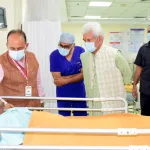DR. FIZA HAMID
”In the growing world, it has now become important to have knowledge and awareness about the most common issues related to our health. Each and every individual should at least have awareness about the most common diseases and problems. Prevention starts from home and it can only happen if people have awareness and general knowledge about the said issues. The main motive of writing the articles is just to provide awareness and necessary knowledge to the people.
Diabetes Mellitus commonly known as ‘High Sugar Level’ is one of the most common and complex metabolic disorders in today’s world. The worldwide prevalence of Diabetes has risen dramatically over the past two decades, from an estimated 30 million cases in 1985 to a humongous number of 415 million in 2017. It’s not over yet, the way we are living in and the trends we are having, it’s not going to decrease but it has been projected that 642 million individuals will have Diabetes by the year 2040 (Ref. International Diabetes Federation) . This disease is hugely influenced by our lifestyle habits and trends. The main factors established to cause the huge rise in the cases is because of increasing obesity, reduced activity levels, as countries are becoming more industrialized, and the aging of the population.
Diabetes in itself contains a bucket of associated diseases and complications which impose a tremendous burden on the individual with diabetes. DM is one of the leading causes of Renal diseases, Gangrenous lower limb Amputations, Cardiovascular diseases, Diabetes is a major cause of blindness, stroke. With an increasing incidence throughout the world, it’s likely to continue to be a leading cause of morbidity and mortality in the future.
Diabetes is a chronic disease that occurs either when the pancreas does not produce enough insulin or when the body cannot effectively use the insulin it produces. Insulin is a hormone that regulates blood glucose. Hyperglycaemia, also called raised blood glucose or raised blood sugar, is a common effect of uncontrolled diabetes and over time leads to serious damage to many of the body’s systems, especially the nerves and blood vessels.
The main two types of Diabetes we should know are – Type 1 Diabetes and Type 2 Diabetes.
Type 1 diabetes
Type 1 diabetes (previously known as insulin-dependent, juvenile or childhood-onset) is characterized by deficient insulin production and requires daily administration of insulin. Neither its cause nor the means to prevent it are known.
Type 2 diabetes
- Type 2 diabetes affects how your body uses sugar (glucose) for energy. It stops the body from using insulin properly, which can lead to high levels of blood sugar if not treated.
- Over time, type 2 diabetes can cause serious damage to the body, especially nerves and blood vessels.
- Type 2 diabetes is often preventable. Factors that contribute to developing type 2 diabetes include being overweight, not getting enough exercise, and genetics.
Early diagnosis is important to prevent the worst effects of type 2 diabetes
- The best way to detect diabetes early is to get regular check-ups and blood tests with a healthcare provider.
- You should visit a doctor and do regular checkups and screening when you find below symptoms-
- Feeling very thirsty, more frequent urination, blurred vision, feeling tired, unintentional weight loss, having slow healing, feeling irritable or having mood changes. These are some main symptoms which you should know in order to diagnose and treat the disease at the earliest.
How we can diagnose and detect the presence of Diabetes
- Symptoms of Diabetes plus Random blood glucose concentration greater than or equal to 11.1 mmol/L (200 mg/dL) or
- For your easy understanding, Random is defined as without regard to time since the last meal, while Fasting is defined as no caloric intake for at least 8 hours.
- Fasting Plasma Glucose(FPG) greater or equal to 7.0 mmol/L (126 mg/dL) or
- Hemoglobin A1c (HbA1c) greater or equal to 6.5 % or
- 2 hour Plasma glucose greater or equal to 11.1 mmol/L (200 mg/dL) during oral glucose tolerance test (OGTT).
- (Ref- International Diabetes Federation IDF)
However the current criteria for the diagnosis of Diabetes emphasize the HbA1c or FPG as the most reliable and convenient tests for identifying DM in asymptomatic individuals.
One of the most important works to prevent Diabetes is to maintain a proper lifestyle and timely screening. Widespread use of Fasting Plasma Glucose or HbA1c as a screening test for type 2 DM is recommended, as a large number of individuals are unaware about the disease, so to diagnose and treat the disease at the earliest we should not hesitate for screening tests, it just takes some time from your busy schedule but in turn can give a happy and healthy life. We shouldn’t be afraid of these screening tests, these should be routinely done after some particular time period in order to keep a check on the health status. Screening tests should be made mandatory for the people having symptoms or people above age 35-40 years.
Lifestyle changes are the best way to prevent or delay the onset of type 2 diabetes
To help prevent type 2 diabetes and its complications, people should:
- Reach and keep a health body weight.
- Stay physically active with at least 30 minutes of moderate exercise each day.
- Eat a healthy diet and avoid sugar and saturated fat.
- Not smoke tobacco. (Ref- WHO)
In conclusion, we can say that Diabetes is a life burdening disease, but the serious complications, and the progression of DM can be prevented only if we follow the proper guidelines and lifestyle. Having some information may help us to prevent the disease and even help us to diagnose it at the earliest for proper treatment.
Prevention is the best Medicine, little changes provide big results.
(Ref- Harrison’s internal medicine, WHO, IDF, Mayo Clinic)
(The Author is MBBS Graduate. Email- [email protected])





